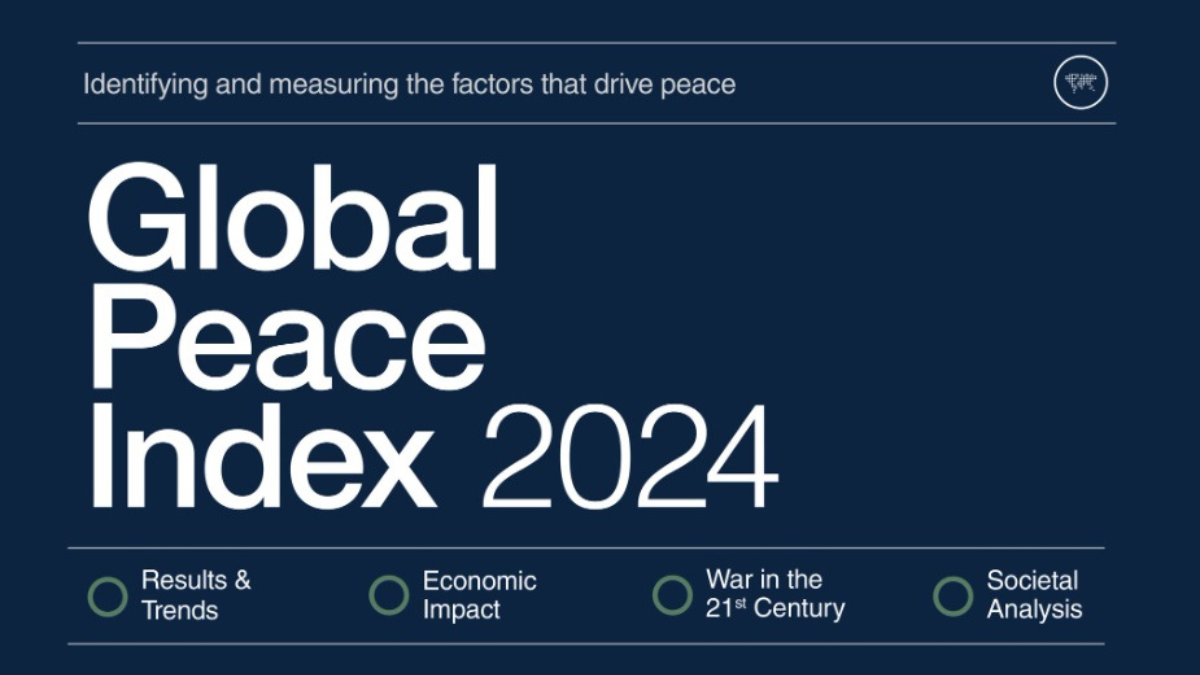Global Peace Index 2024: An Overview
3 min read
The Global Peace Index (GPI) 2024, published by the Institute for Economics & Peace (IEP), provides a comprehensive measure of global peacefulness, evaluating 163 independent states and territories. This report highlights the trends, results, and economic impacts of violence across the world, offering valuable insights into the current state of peace and the factors influencing it.
Key Findings
Overall Peacefulness
- Global Peace Deterioration: The average level of global peacefulness deteriorated by 0.56% in 2024. This marks the fifth consecutive year of declining peacefulness.
- Country Improvements and Deteriorations: In the past year, 65 countries recorded improvements in peacefulness, while 97 countries saw deteriorations. This is the highest number of countries to experience a decline in a single year since the index’s inception.
Regional Highlights
- Most Peaceful Countries: Iceland remains the most peaceful country, a position it has held since 2008, followed by Ireland, Austria, New Zealand, and Singapore.
- Least Peaceful Countries: Yemen is now the least peaceful country, followed by Sudan, South Sudan, Afghanistan, and Ukraine.
Regional Performance
- Europe: Europe continues to be the most peaceful region, despite a slight deterioration in peacefulness over the past year.
- Middle East and North Africa (MENA): MENA remains the least peaceful region, with significant conflicts in countries like Yemen and Sudan contributing to its low ranking.
- North America: North America recorded the largest regional deterioration, driven by increased violent crime and perceptions of criminality in both Canada and the US.
Trends in Peacefulness
- Militarisation: The Militarisation domain saw the largest year-on-year deterioration. Military expenditure (% of GDP) increased in 86 countries, reflecting broader trends of rising militarisation.
- Ongoing Conflict: The Ongoing Conflict domain also deteriorated significantly, influenced by ongoing wars in Gaza and Ukraine. The number of conflicts involving at least one state has reached a new high.
- Safety and Security: This domain recorded a slight improvement, driven by reductions in violent demonstrations, terrorism impact, and the homicide rate in several regions.
Economic Impact of Violence
- Global Cost: The economic impact of violence on the global economy in 2023 was $19.1 trillion, equivalent to 13.5% of global GDP or $2,380 per person.
- Conflict Costs: The conflict in Ukraine had a significant economic impact, shrinking Ukraine’s economy by an estimated 30% in 2022. The Syrian civil war has led to an 85% drop in GDP since its onset.
- Military and Security Expenditure: Over 74% of the total economic impact of violence is attributed to military and internal security expenditure, with military spending alone accounting for $8.4 trillion.
War in the 21st Century
- Changing Nature of Conflict: Modern warfare is increasingly characterised by technological advancements and geopolitical competition. Non-state actors are now more capable of engaging larger states using technologies like drones.
- Internationalisation of Conflict: Conflicts are becoming more internationalised, with 92 countries now engaged in conflicts beyond their borders. This complicates negotiation processes and prolongs conflicts.
- Asymmetric Warfare: The rise of asymmetric warfare, including drone attacks by non-state groups, has made conflicts more complex and harder to resolve.
Positive Peace and the Halo Approach
- Positive Peace: Defined as the attitudes, institutions, and structures that create and sustain peaceful societies, Positive Peace is crucial for forecasting and mitigating future conflicts.
- Halo Approach: IEP’s Halo approach provides a framework for analyzing societal systems and designing resilience-building programs. This adaptive approach helps in creating effective policies for building Positive Peace.
Table of Rankings
| Rank | Country | Score | Change in Rank |
|---|---|---|---|
| 1 | Iceland | 1.112 | ↔ |
| 2 | Ireland | 1.303 | ↔ |
| 3 | Austria | 1.313 | ↑1 |
| 4 | New Zealand | 1.323 | ↓1 |
| 5 | Singapore | 1.339 | ↑3 |
| 6 | Switzerland | 1.35 | ↑3 |
| 7 | Portugal | 1.372 | ↓1 |
| 8 | Denmark | 1.382 | ↓3 |
| 9 | Slovenia | 1.395 | ↓2 |
| 10 | Malaysia | 1.427 | ↑2 |
| 116 | India | 2.319 | ↑5 |
| 163 | Yemen | 3.397 | ↓2 |






